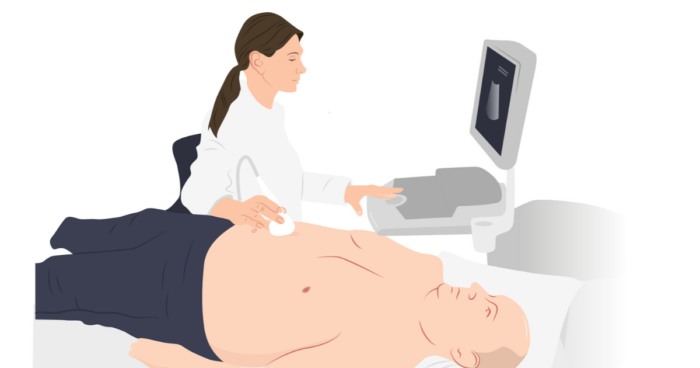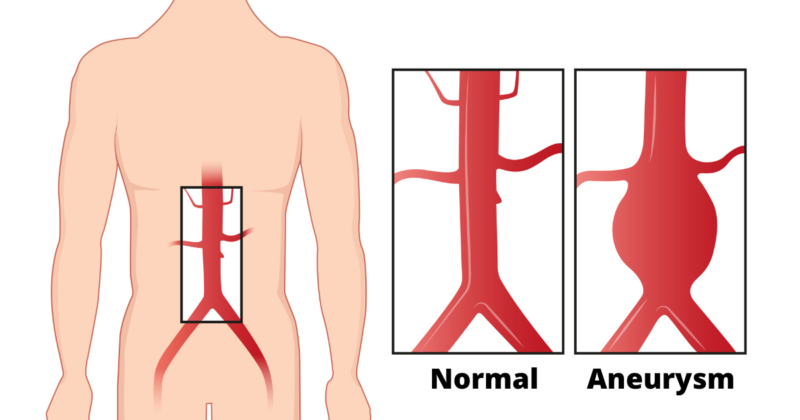Arteries are blood vessels that carry blood from your heart to the rest of your body. An aneurysm occurs when the wall of an artery weakens and bulges outwards like a balloon.
The aorta is your largest artery. It comes directly off the heart in your chest and descends into your abdomen. Branches of the aorta send blood to your head, arms, chest, abdomen, and legs.
The abdominal aorta is the section of the aorta in your abdomen, below your diaphragm. It’s normally no wider than 2 cm.
Let’s put all those A’s together.
An abdominal aortic aneurysm (AAA) is a bulge in the abdominal aorta with a total width of 3 cm or greater.
Ruptured AAA is usually fatal
So what’s the danger of an AAA? When an AAA grows beyond 5.5 cm, the risk of rupture begins to rise significantly. Rupture is just as awful as it sounds. A ruptured AAA causes massive internal bleeding.
Trust me, you do not want your aorta to rupture because it’s fatal in 81% of cases. Most victims die before reaching the hospital. Even if you reach the hospital, there’s not much that can be done.
So the goal is to detect an AAA early enough to do something about it before it ruptures.
Screening for AAA
Screening means getting tested for a disease before it causes symptoms or serious problems.
I might be able to feel the pulse of a patient’s aorta just above the belly button, but it’s difficult to tell if there’s an aneurysm or not.
Fortunately, an ultrasound is a quick and noninvasive screening test for AAA. Ultrasound uses high-frequency sound waves to create a live, dynamic image.

Who needs screening for AAA?
Risk factors for AAA include:
- Male
- Older age
- Smoking (the strongest risk factor for AAA)
- Atherosclerosis, or hardened plaque buildup inside arteries, which in turn is caused by high cholesterol, high blood pressure, and other conditions [read about 7 consequences of high cholesterol]
- Having a family member with AAA
- Caucasian
But just because you have one of the risk factors doesn’t mean you should get an ultrasound. Screening is recommended in people who are at high enough risk such that the benefit of screening outweighs the harms.
The US Preventive Services Task Force recommends that men aged 65 to 75 years who have ever smoked should have an ultrasound to screen for AAA. One-time screening in this group lowers the risk of dying due to AAA.
Why men? Because men are 6 times more likely than women to have an AAA.
Why age 65 to 75? It’s important to get screened at a time when there’s a reasonable chance of having an AAA but early enough that treatment would be beneficial. Most of the research looking at the benefit of AAA screening included men aged 65 to 75.
What level of smoking? In public health research, “ever smoked” is defined as someone who has smoked 100 or more cigarettes in their lifetime.
In contrast, screening for AAA in women who have never smoked and have no family history of AAA is not recommended.
Screening might be appropriate in some men aged 65 to 75 who have never smoked. This is an intermediate group.
What if the ultrasound finds an AAA?
If there is an AAA found on ultrasound, the next steps depend largely on the size of the aneurysm. The magic number is 5.5 cm.
If the AAA is less then 5.5 cm wide, the risk of surgery to repair the AAA is greater than the risk of AAA rupture. Therefore, surgery is not usually recommended unless the AAA has been growing rapidly. Instead of surgery, most experts recommend the following:
- Quit smoking or don’t start smoking
- Make sure blood pressure is under control
- Address other risk factors for atherosclerosis and heart disease
- Monitor the size of the AAA regularly with ultrasounds
With an AAA of 5.5 cm or greater, the risk of rupture is greater than the risk of surgery. At this point, surgery is recommended. Surgery can be done with a traditional large incision (open repair) or by working inside the aorta with specialized instruments (endovascular repair).

